



The moon covers the sun during a total solar eclipse Aug. 21, 2017, in Cerulean, Ky. On April 8, 2024, the sun will pull another disappearing act across parts of Mexico, the U.S. and Canada, turning day into night for up to 4 minutes, 28 seconds. (AP)
Some state and local officials are encouraging people who live in communities along the April solar eclipse’s path of totality to brace for complications such as traffic jams and overtaxed cell phone networks caused by crowds of out-of-town eclipse viewers.
We did not find emergency management officials advising people who live outside the eclipse’s path to stock up on food, water or fuel ahead of the rare astronomical event.
Learn more about PolitiFact’s fact-checking process and rating system.
When the moon’s shadow briefly darkens cities across the U.S. on April 8, it won’t deplete fuel and food supplies or knock out cellphone service.
Before the total solar eclipse, officials in states and towns along the eclipse’s path of totality are encouraging residents to prepare for large crowds; some social media users have shared the guidance without critical context.
Emergency officials warn to "stock up on food, water, and fuel ahead of the eclipse," read the text in a March 14 Facebook reel. "Cell phone service could be a problem too."
This post was flagged as part of Meta’s efforts to combat false news and misinformation on its News Feed. (Read more about our partnership with Meta, which owns Facebook and Instagram.)
The reel’s caption said "the EMA," which appears to refer to the Emergency Management Agency, encouraged people to stock up on supplies before the eclipse and warned that cell phone signals might be lost due to activity overload. The post’s language is similar to more ominous claims we have checked warning people of alleged emergencies and doomsday scenarios.
The post’s caption also linked to a March 13 IFLScience article, which included important context that the Facebook post lacked.
In the article’s first sentence, it said that Emergency Management Agency officials in Lorain County, Ohio, in the path of totality, encouraged residents "to stock up on food, water, and fuel ahead of the total eclipse on April 8, with an influx of visitors to the area expected."

This image from the NASA Eclipse Explorer website shows the path of the April 8, 2024 total solar eclipse over North America. (NASA via AP)
The information was provided in anticipation of large crowds, not because of complications from the eclipse.
Lorain County officials posted "resident preparation tips" focused on ways to avoid problems caused by a visitor spike.
Because the eclipse will come on a Monday, "it is likely that many visitors will come in over the weekend and stay in the area," Lorain County officials wrote.
Visitors could cause "difficulty accessing food, gas, and supplies due to traffic issues" and "possible loss of cell phone signal due to system overload," officials wrote. They advised residents to buy gasoline and stock up on food and drinks before April 6 and also said residents should avoid traveling that weekend.
PolitiFact found other examples of state and local officials in cities along the eclipse’s path of totality warning residents to prepare for crowds of visitors. Similar warnings were issued in 2017, before the Aug. 21 total solar eclipse that year.

This multiple exposure photograph shows the progression of a partial solar eclipse over the Gateway Arch in St. Louis on Aug. 21, 2017. (AP)
In 2017, the Federal Emergency Management Agency warned of "gridlocked traffic conditions," "travelers stopped on roadways," "distracted driving during the event," and "limited cell phone service" or "limited gasoline availability" because of the large gatherings along the path of totality. News organizations at the time reported possible phone service outages because crowds might overtax networks, not because the eclipse would affect phone service.
In 2017 and now, suggestions to buy food and fuel early focused on complications from large crowds — not from the rare solar event itself. For people living outside the path of totality, we did not find similar eclipse guidance then or now.
A Facebook reel’s text said emergency officials warn to "stock up on food, water, and fuel ahead of the eclipse."
The reel’s lack of specificity could have had people thinking that national emergency management officials were warning the April eclipse might cause complications on its own. We found that some local and state officials are encouraging people living along the eclipse’s path of totality to brace for complications caused by crowds of out-of-town eclipse viewers.
The post’s claim is partially accurate, but omits important details. We rate it Half True.
PolitiFact Researcher Caryn Baird contributed to this report.
Facebook post, March 14, 2024
IFLScience, About, accessed March 18, 2024
IFLScience, Stock Up On Food, Water, And Fuel Ahead Of The Eclipse, Emergency Officials Warn, March 13, 2024
Lorain County Ohio, April 8th, 2024 Total Solar Eclipse, March 18, 2024
Newsweek, Map Shows Warnings for People to Stock Up on Food Ahead of Solar Eclipse, March 18, 2024
NASA, How the 2024 Total Solar Eclipse Is Different than the 2017 Eclipse, Jan. 30, 2024
KXAN, Hays County braces for influx of visitors coming to witness the total eclipse, March 15, 2024
Spectrum News 1, Caution recommended ahead of large eclipse crowds, Feb. 22, 2024
Federal Emergency Management Agency, FEMA Provides Tips on How to Plan Ahead For the Aug. 21 Solar Eclipse, Aug. 18, 2017
Fox 8, Phone providers confident eclipse tourists won’t disrupt network, March 7, 2024
MIC, Your cell service might cut out during the eclipse, but providers are working to give it a boost, Aug. 1, 2017
Bustle, The August 21 Solar Eclipse Could Majorly Mess With Your Cell Service, Aug. 3, 2017
In a world of wild talk and fake news, help us stand up for the facts.
